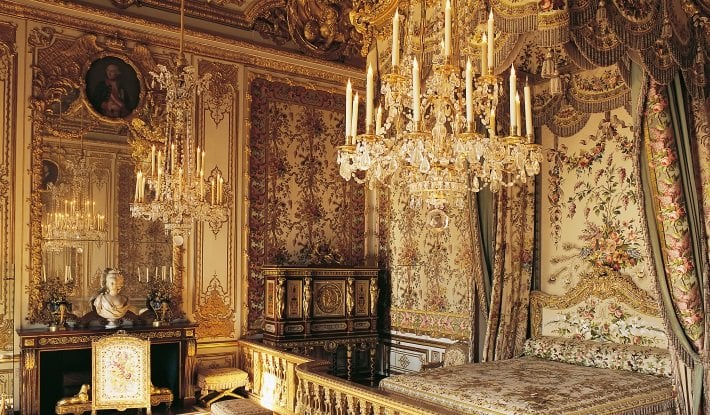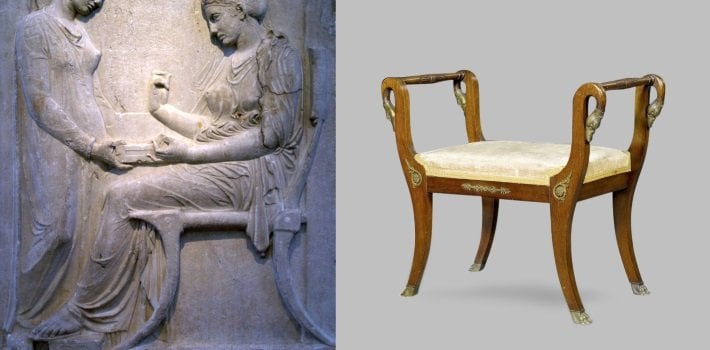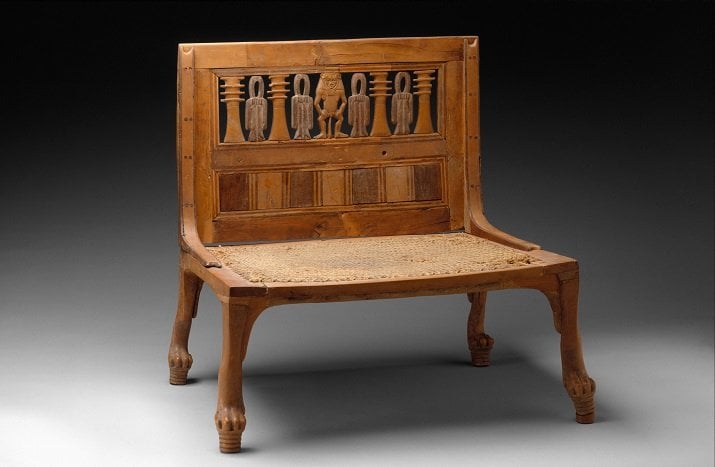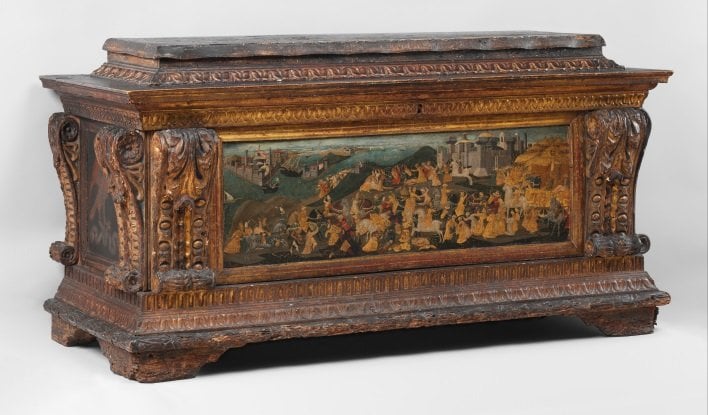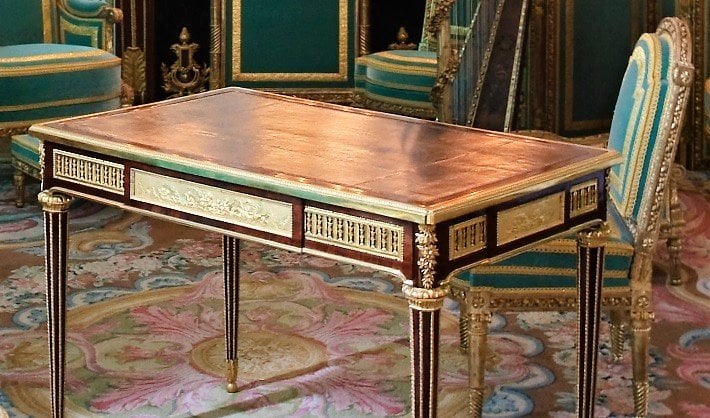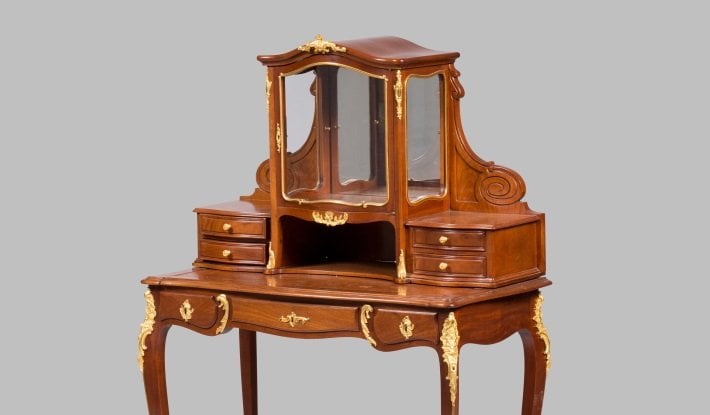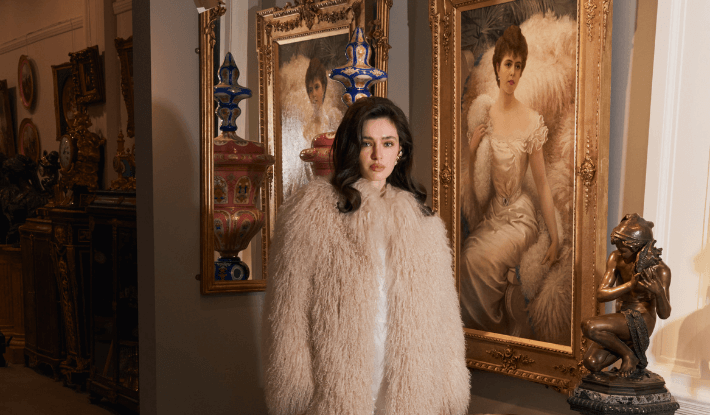In today’s busy world, it is easy to take our items of furniture for granted. We sit on chairs and sleep in beds, and it has always been so. Or has it?
The Mayfair Gallery history of antique furniture traces furniture design back to the beginning of human existence. By plotting the evolution of furniture styles through the ages, it becomes clear how the role of furniture has changed from a functional item of necessity to a luxurious form of art and design.
The origins of furniture and first creations
When humans first walked the earth, they did not stay in one place for long. Instead, these early hunter-gatherers led a nomadic lifestyle, moving with the seasons and the beasts that they hunted.
The frequent movement of these groups meant that large, non-portable items of furniture were redundant.
Instead, our earliest ancestors experimented with whatever natural objects were present in close proximity to them, using these to form the very first chairs and tables out of rocks and tree stumps.
Astonishingly, the hunting and gathering period is the longest part of humanity’s presence on earth, accounting for ninety-percent of our time here.
But gradually, these hunter-gatherer communities began to use the land around them for farming. By developing into agricultural societies, our early ancestors were able to remain in one place for long periods of time.
Because they were settled in one place, these new farming communities could now craft large items of furniture from natural resources and keep them in a permanent location.
More complex pieces of furniture – usually carved from wood, stone or animal bones – were thus created by these agricultural societies.
Sadly, almost no evidence survives of these earliest furniture creations because they were largely made from perishable materials.
One exception to this is the Neolithic village of Skara Brae in Scotland. Dating from 3100-2500 BC, every house at Skara Brae exhibits an impressive range of sophisticated stone furniture, including beds, shelves, cupboards and dressers.
House at Skara Brae, showing built-in stone furniture
Early furniture design and the influence of Greece
At the same time as the developments of Skara Brae, Bronze Age civilisations all across the world were independently becoming more innovative in the field of furniture design and construction.
As societies began to refine and improve the works of furniture that they produced, furniture became more decorative in design.
And so, these ancient societies began to turn what had been a humble craftsmanship into a highly skilled form of art.
The ancient Greeks were particularly advanced in the designs they used. One of the most creative furniture developments made by the ancient Greeks was to create items of furniture with curved features, such as the legs and backs of chairs and tables.
Much stylistic design that we admire in antique furniture today is derived from that of the ancient Greeks, and similarities can be clearly seen when we compare the antique with the ancient.
For example, on an ancient Greek gravestone, known as the Stele of Hegeso, we see a depiction of the deceased woman sitting on a chair.
The seat has gently curved legs and back, in a manner typical of ancient Greek furniture style. A similar design can be seen on a 19th Century Empire style stool, with its outward curved legs.
The gravestone of Hegeso, c. 400 BC compared to a 19th Century Empire period antique mahogany stool, with curved legs in the ancient Greek style. © Kallimachos (Marsyas, 2006) via Wikimedia Commons
It is astonishing that these styles, first imagined over 2000 years ago, still have an enormous influence on what we consider to be desirable traits in luxurious works of furniture.
Ancient furniture and the importance of Egypt
Since few items of furniture have survived from ancient times, our knowledge of early furniture design is largely derived from its depiction in art forms, such as frescos and pottery decorations.
A welcome exception to this general rule is ancient Egyptian furniture, much of which has been preserved in hot, dry and dusty tombs. When the ancient Egyptians buried their dead, they placed furniture and other objects alongside the deceased for use in the afterlife.
An exceptional example of ancient Egyptian furniture is a low, straight-backed wooden chair, which belonged to an important Egyptian woman called Hatnefer.
Hatnefer's low straight-backed chair, built roughly between 1492-1473 BC
This Egyptian chair features carved ebony, boxwood and cypress details. This highly decorative ancient piece shows the early transition of furniture from functional object to work of art.
Furniture in China and the East
As craftsmen experimented across the world, furniture design and techniques grew more complex and refined.
However, furniture construction and design developed at different speeds throughout the globe.
In sharp contrast to today’s globalised world, ideas and techniques often didn’t spread for decades or centuries, meaning that local designs grew independently from one territory to the next. Much early furniture design was therefore the result of regional customs and activities, made from materials that were the most readily available.
In China, for instance, highly skilled bamboo production techniques were used to craft works such as beds, cabinets, stools and tables.
Such was the skill of this early craftsmanship, that the bamboo production techniques of ancient China are still used in the present day.
Furniture in Medieval times
Following the collapse of the Roman Empire in 476 CE, Europe entered into a period known as the Middle Ages. During this time, artistic production fell into decline. As a result, only the most basic and essential furniture was produced.
Furniture in the Middle Ages was usually made from wood, as the material was easy to craft and long-lasting. Heavily carved and decorated in the Gothic style, medieval furniture often featured religious themes and heraldic imagery.
Illustration of a medieval scholar at his writing desk, early 14th Century; note the heavy wooden bench on which he sits and the dark wooden writing stand
Intriguingly, much medieval furniture also includes a gargoyle motif. The presence of these small, ugly monsters was believed to frighten away evil spirits.
Renaissance furniture in Europe (14th – 17th Centuries)
Furniture during the Renaissance period shifted away from the influence of Gothic design, drawing on biblical and historical themes instead.
The era was inspired by the ideals of ancient Greek and Roman Classical societies, and furniture design reflected these sensitivities.
As design moved away from the more basic forms of the Middle Ages, the appearance of furniture became important again, elevating the best works produced to luxury status. Items such as this chest, below, spoke to a new desire for more ornate and finely decorated furniture.
Finely detailed Italian Renaissance chest with painted front panel depicting the Conquest of Trebizond, 15th Century
This refinement during the Renaissance increasingly led to the incorporation of intricate scrollwork and natural foliate imagery into new items of furniture, together with the use of more elaborate materials.
Marble and mosaic tabletops became fashionable, and the increase in European textile production meant that upholstered furniture became commonplace.
The Golden Age: French furniture in the 17th and 18th Centuries
While furniture once again became prized as a decorative art form during the Renaissance, it wasn’t until the 17th Century that furniture’s status as the pinnacle of luxury was secured.
This rise in popularity of fine furniture was largely due to the desires and power of European royalty and aristocracy, who spared no expense on interior decoration and indulged in opulence, luxury and comfort.
Nowhere was this more apparent than France, where King Louis XIV (1638-1715) spent vast sums of money on works made from the finest materials, including exotic wood, imported lacquer, silver, ivory and mother-of-pearl.
17th Century portrait of Louis XIV (left) and early 18th Century French commode by Andre Charles Boulle, demonstrating extravagant decoration and impressively detailed design (right)
French makers – adapting to the demand for extravagance – came to be regarded as the most sophisticated masters of furniture production across the world, inspiring generations of furniture craftsmen.
It was during this period, that French bronziers mastered the process of gilding metal to produce ormolu, otherwise known as gilt bronze.
Using the ormolu technique, large items of furniture could now appear to have been crafted from solid gold, and so it's no wonder that furniture incorporating ormolu mounts became highly sought after amongst the elite.
The highly intricate ‘Boulle marquetry’ technique, named after its inventor Andre-Charles Boulle, was also a product of the Louis XIV period.
Although the furniture produced during the reign of Louis XIV is often categorised as Baroque in style, in fact Louis XIV style furniture is more playful and inventive. Creative craftsmen experimented with innovative new techniques and incorporated these into the existing Baroque style.
Detail of a Victorian period vitrine, showing the fine Boulle work and splendid ormolu mounts
The playful elements of Louis XIV design paved the way for the flamboyant Rococo style, which is synonymous with the rule of the French King Louis XV (1710-1774).
Ruling until his death in 1774, Louis XV is famous for his love of sumptuous Rococo furniture, which it typified by its florid, ornate and asymmetric designs.
The Rococo style is now often referred to as ‘Louis XV’ or ‘Louis Quinze’ style, although it was in fact the influential mistress of Louis XV, Madame de Pompadour, who popularised the Rococo style at the time.
Portrait of Madame de Pompadour by Francois Boucher, 1756; note the ornate scrolling legs and florid detailing of the side table, both typical elements of Rococo style
On the death of Louis XV, his grandson Louis XVI (1754-1793) assumed control of the French throne.
His reign is synonymous with the transition from the curvaceous exuberance of the Rococo style to the geometric refinement of the Neoclassical style, which is often referred to as ‘Louis XVI’ or ‘Louis Seize’ style.
As its name suggests, the new Neoclassical style was inspired by the ancient Greek and Roman Classical civilisations.
It was actually the wife of Louis XVI, the famous Marie Antoinette, who brought Neoclassicism to the French court rather than the King himself.
Famed for her love of design and fashion, the flamboyant French Queen insisted on the Palace of Versailles being updated in the Neoclassical style.
Marie Antoinette’s desk, French 1783; note the fluted, tapered table legs and straight backed chairs; both typical of Neoclassical design. © Myrabella via Wikimedia Commons
Sitting on the shoulders of giants: French furniture in the 19th Century
The so-called Golden Age, covered by the reigns of Louis XIV, XV and XVI had produced some of the most exquisite items of furniture of all time.
The resultant move into 19th Century furniture design was not a reaction against what had gone before, but rather a celebration and a revival of these earlier styles, with a particular emphasis on European Rococo and Neoclassical design.
Furniture of the 19th Century therefore exhibited a masterful reinvention and modernisation of styles from previous centuries.
A good example of this reworking and fusion of earlier styles can be seen in the work of the the Parisian ébéniste François Linke (1855-1946) in the side cabinet below.
The Art Journal reported at the time, "The work of M. Linke ... was an example of what can be done by seeking inspiration amongst the classic examples of Louis XV and XVI without in any great sense copying these great works. M. Linke's work was original in the true sense of the word."
Ormolu, kingwood and Vernis Martin side cabinet by Francois Linke, which incorporates Baroque, Rococo and Neoclassical features and uses the Vernis Martin technique
Improvements in global communications were also partly responsible for the new designs exhibited by the 19th Century European furniture masters.
The faster speed of exchange between Western and Eastern cultures had resulted in a flow of artistic and cultural styles from continent to continent.
19th Century European furniture makers were therefore able to explore a multitude of new materials and sources of inspiration, resulting in the use of exotic woods originating from distant lands, such as mahogany, ebony and amboyna burr.
New styles and techniques, inspired from other continents, were also adopted by Eurpean furniture makers.
The Vernis Martin technique for example, which involves the use of a thick lacquer finish and detailed inlays, originated in the East and spread to the West, and new trends such as Japonism took root in Europe.
New Furniture Creations in the 19th Century
Not only were 19th Century furniture makers experimenting with new techniques and materials, they were also creating entirely novel pieces.
In the 19th Century, cabinets and vitrines became popular in interior spaces which were used to entertain guests, as they could display the precious wares of the host.
Napoleon III style ebonised wood vitrine, French 19th Century; the glass panels allow for easy display of precious wares
The 19th Century similarly saw a rise in popularity of the bonheur du jour, a type of ladies writing desk with small compartments for storing trinkets.
The bonheur du jour was particularly fascinating on account of the possibility that it could be used to store secrets, which its owner wished to conceal from others.
In some ways, 19th Century bonheur du jours present the ultimate furniture paradox: lavishly decorated and hugely expensive, these pieces were designed to be seen and admired, but also to conceal private things that should not be seen.
Such was the influence of 19th Century furniture on other art forms, that the notion of the locked desk – particularly the secret door of a woman’s writing cabinet containing private letters – remained a theme in European literature well into the 20th Century.
Antique mahogany bonheur du jour by Guillaume Grohé, c. 1880
Furniture in the 20th Century and Collecting Antiques
Through the 19th Century, industrialisation affected all areas of society, especially manufacturing, and this had an increasingly prominent impact on furniture making and consumption.
This trend continued into the 20th Century with further mechanical developments and the invention of man-made materials, notably plastics, meaning furniture could be produced at lower cost and requiring less input from craftsmen.
Instead the role of the ‘designer’ came to the fore, feeding their designs to machines to be produced and reproduced many times over, thus making furniture more affordable and easier to access for all social classes.
These developments coincided with the changes in style away from the those of the 19th Century. The Arts and Crafts movement and Art Nouveau were followed by Art Deco and then Modernism.
Minimalism as a design concept grew through the second half of the 20th Century, and perhaps best reflects the move away from the fineness of detail and qualities associated with French furniture of the 18th and 19th Centuries.
Rather these antique pieces, which contrasted greatly with the modern creations of the day, were now valued as unique one-of-a-kind pieces, with the craft and skill employed in their creation celebrated as an artform.
The practice of collecting and accumulating precious works of old furniture found favour and it became customary to pass these items of furniture down through the generations.
This tradition lives on as antique furniture collections are built and treasured as family heirlooms.




